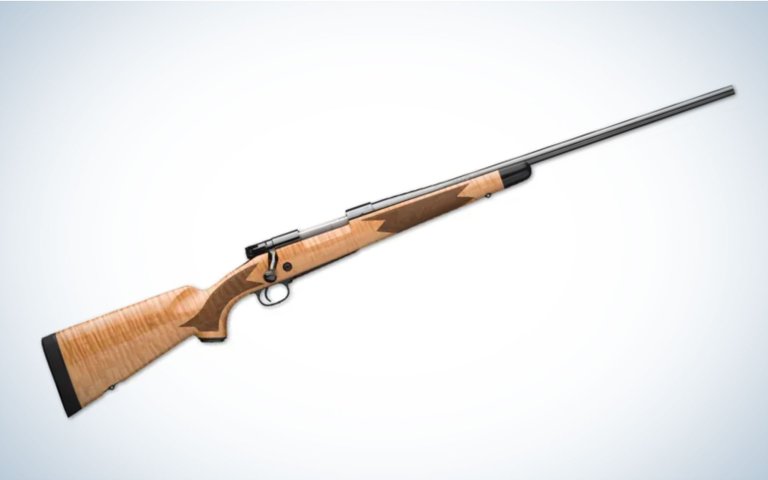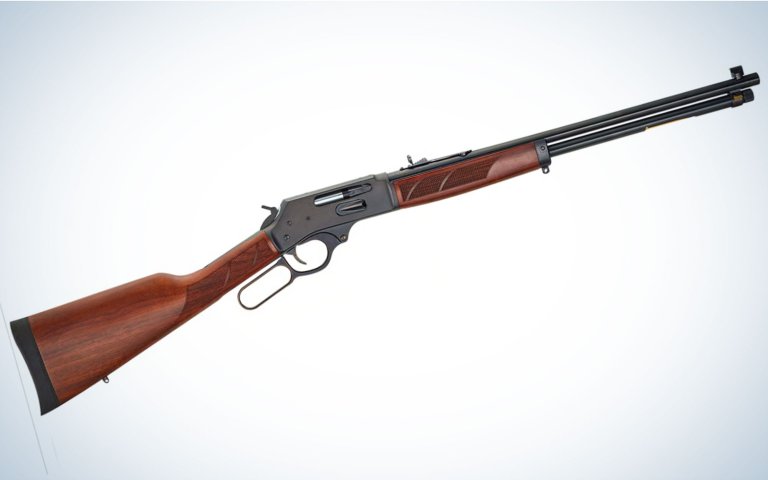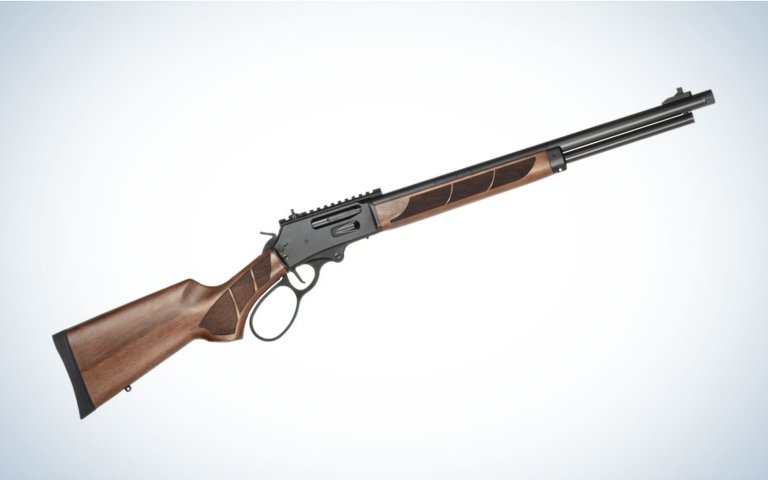Let’s get this part out of the way first: I am not a Fudd. I own lots of rifles and shotguns with synthetic stocks, I’ve shot smart scopes, and I’ve hunted with AR-style rifles. Plus, I’m a Millennial, at least as defined by age. I know that new shooting technology is useful and has its place. But I think that those traditional, wood-stocked bolt-action rifles have their place, too.
In my opinion, that place is deer camp where tradition thrives. The gold standard here would be hunting with Grandpa’s old gun (perhaps a Savage 99 or Marlin 336). But maybe you didn’t grow up in a deer hunting family, or maybe Grandpa is still hunting with his rifle. Sure, you could shop around for a classic used rifle (maybe an old Remington 700 or a Winchester Model 70), but the nicks and scratches in that rifle won’t be yours. I think there’s still value in buying a new, wood-stocked rifle, marking it with your own memories, and then one day passing it down.
The good news is there are still plenty of quality rifles being made with wood stocks. Last fall, I spent my deer season hunting with a Winchester Model 70 Super Grade rifle that’s fitted with a beautiful maple stock. And, I plan to hunt with this gun for many deer seasons to come.
Best Bolt-Action Wood Stocked Rifles
- Winchester Model 70 Super Grade
- Browning X-Bolt 2 Medallion
- Sako 90 Hunter
- Weatherby Mark V Deluxe
- Tikka T3x Hunter
Best Lever Gun Wood Stocked Rifles
Best Bolt Action Wood Stocked Rifles
Winchester Model 70 Super Grade
My 8-pound Model 70 Super Grade in .30-06 is not the highest performance rifle out there. You’re not going to want to carry it into the mountains on a sheep hunt and you’re certainly not going to win a PRS match with it. But damn it looks good.
The AAAA grade stock is red maple (though some sugar maples make the grade, too) from the Appalachian Mountains. Each log is inspected and purchased individually by Tech Woods USA, according to Winchester product manager Glenn Hatt. The stock blank is heat-treated, graded, certified, and then sent to the Winchester factory in Portugal where the stocks are machined, checkerd, finished, and then bedded onto the rifles.
“The heat treatment of the maple stocks also changes the color of the stocks so they aren’t so much a white-blonde but have a more of a yellow, antique look that really lets the flame or tiger striping pop, especially with our gloss finish,” Hatt says. “The added rigidity, stiffness, and resistance to moisture variations are also extreme benefits. After Tech Woods USA hand selects each tree, we hand select each blank and mark it … This ensures that it meets our tight criteria for ambrosia (dark worm lines in the stock), knots, and any other blemishes and guarantees that the stock meets our quality standards.”
There’s also a walnut version and the rifle is widely available in a whole bunch of chamberings.
Browning X-Bolt 2 Medallion
I was a little kid when my dad first showed me his deer rifle —— a beautiful Browning A-Bolt Medallion that my mom had given him as a wedding gift —— and instructed me on how to handle the gun safely and avoid touching the metal on the barrel or the lenses on the scope with my grimy hands. Even as a child I could tell that the rifle was imminently important, even if I wasn’t exactly sure why. My dad loves that gun, and he still hunts with it today.
The modern X-Bolts are even better and come with Grade III walnut stock, rosewood caps, and a gloss finish.
Sako 90 Hunter
The synthetic stocked version of the Sako 90 won our editor’s choice award in the 2024 Rifle Test. This was in no small part because of how accurate it was (read the full review here).
“If one set out to design the perfect traditional hunting rifle it would look a lot like the Sako 90 Adventure,” wrote shooting editor John B. Snow. “At first glance you might wonder whether such praise is warranted. The traditional American stock isn’t nearly as avant-garde as many of the competition-inspired lightweight stocks that have gained traction in recent years. And the heart of the rifle — Sako’s three-lug bolt action — has been a fixture in the Finnish gunmaker’s line for decades.”
Fortunately for traditionalists, the rifle also comes in Grade 2 walnut stock version.
Weatherby Mark V Deluxe

Weatherby, like most rifle companies these days, has put a lot of effort into making modern looking rifles with carbon stocks and fluted barrels. But they still offer their gorgeous, glossy, and classic Mark V Deluxe. The rifle is a blast from the past (in a good way) and features AA walnut wood, a rosewood fore-end and a grip cap with maplewood spacers. It’s available in the Weatherby cartridges along with .243, 25 Creed, and 6.5 Creed.
Tikka T3x Hunter
Outdoor Life editors have had great success shooting the T3x line of Tikka rifles, including the ultra accurate T3x UPR and utilitarian T3x Lite. That should come as no surprise since Tikka is well known for affordable field accuracy. Their T3x Hunter rifle can be easily found for under a grand in a wide variety of chamberings — and left-handed models. It features a nice, but not fancy, walnut stock.
Best Lever Gun Wood Stocked Rifles
Marlin 336 Classic
The new Marlin is on a hot streak and their reintroduced 336 impressed us so much it earned an editor’s choice in 2023. “In short, the Marlin 336, like the 1895 SBL, is an example of modern manufacturing processes pulling on the oars to make the best lever actions to ever wear the Marlin bullseye and horse-and-rider logo,” wrote shooting editor John B. Snow. “And I say that as someone who grew up with these rifles, which until the early 2000s were built just down the road from my home in Connecticut.”
The rifle is chambered in .30-30 (of course) and has an American black walnut stock. The only downside of this gun is that it’s hard to find in stock anywhere.
Henry Side Gate
As a Wisconsin deer hunter, I have a soft spot for Henry rifles, which are made in Rice Lake (the company’s slogan is “Made in America, or not at all”). This lever gun is chambered in some terrific big woods deer hunting cartridges, including .30-30, .35 Remington, .360 Buckhammer, .38-55 Win, and .45-70. You can also choose from a more subtle steel receiver or the classic Henry brass receiver style.
Smith & Wesson 1854
S&W is a new player in the modern lever gun market and their rifle is nothing short of impressive. “It’s a testament to the skill and vision of the engineers, designers, and everyone else who had a hand in bringing it to fruition,” Snow wrote when he reviewed the gun last year. “It also dramatically changes the lever-action landscape. For the last few years Marlin and Henry Repeating Arms have been the dominant source for readily available high-quality lever guns. With the Model 1854, Smith & Wesson has shown there’s a new player in town — and the main beneficiary will be hunters and shooters who now have more choices to pick from.”
The wood-stocked version is available in .30-30, .45-70, 44 mag, and .357 mag.
Browning BLR
If you want to shoot a lever gun that’s chambered in, say, 6.5 Creedmoor, then the BLR is for you. This light and handy lever gun is available in a variety of popular big-game cartridges, utilizes a box magazine, and sports Grade I walnut. You can find them new for just over a grand.
The Case for Modern Wood-Stocked Deer Rifles

I will not argue that modern precision rifles with synthetic stocks offer superior accuracy. However, I don’t need much performance out of a deer rifle. In 24 years of deer hunting Wisconsin’s Northwoods, I’ve never needed to make a shot farther than 200 yards. I bet that is true for most whitetail hunters reading this story as well.
Many of my shots are made in the woods at close ranges. Anyone who has hunted the hectic 9-day Wisconsin gun season knows that shots at bucks are usually quick ones, taken while the deer is moving through timber. My shooting is done from a treestand, usually offhand, or braced against a tree. For this kind of work I want a rifle that comes to my shoulder quickly, points naturally, and runs smoothly. The Winchester Super Grade and many other modern wood stocked rifles are built to do just that.
As for accuracy, any rifle that shoots around 2-inch groups from the bench, with hunting ammo, will suffice. That might sound like heresy in the era of sub-MOA guarantees, but it’s a realistic perspective. On any given shot in the Wisconsin deer woods, I’m essentially trying to hit an 8-inch oval that overlaps a buck’s front shoulder at ranges of 50 to 200 yards. I do not need sub-MOA accuracy out of my rifle and load to do this.
Beyond performance requirements, I want the rifle to look like the rifles of my childhood. For Wisconsin deer camp, I want to hunt with a rifle that brings back that kind of reverence.
Wood vs. Synthetic Stocks

There are, of course, good reasons why hunters and shooters have moved toward synthetic stocks. They are typically more durable, lighter, more consistent, and often more affordable.
“Wood is an organic material that reacts to its environment,” says shooting editor John B. Snow, who has seen the dramatic shift toward synthetic stocks during his long tenure at Outdoor Life. “And wood is also, well, squishy, which is an issue. There are ways to mitigate it and to try to seal wood against the environment. Done right, you can pretty much do the job. But if you’re talking about a basic wood-stocked rifle, it’s going to be environmentally susceptible compared to a well-made synthetic stock.”
Since synthetic-stocked rifles started cropping up decades ago, they’ve taken over the rifle market and now the most precise custom rifles — and, on the flip side, many of the cheapest hunting rifles — come with synthetic stocks.
“When I was getting going at Outdoor Life, a synthetic-stocked rifle was looked at like a turd in a punch bowl,” Snow says. “The feeling was, ‘Why would you want that ugly thing?’ But it’s shifted to the point where you can hardly find a custom gun maker who makes a wood-stocked rifle anymore.
“What drove the trend was performance. When gunmakers like Kenny Jarret or Ed Brown started making good synthetic rifles, accuracy was part of their promise. Then you’ve got the Gunwerks and George Gardners of the world, they never even considered wood … Look at Melvin Forbes. His synthetic stocks are a work of art. They weigh just mere ounces and they’re just strong as hell. I’ve written before that you could beat a cape buffalo to death with one and it wouldn’t break.”
But a wood-stocked rifle isn’t inherently less accurate than its synthetic counterpart out of the box. That’s a total fallacy. The difference is that wood is more susceptible to warping over time, which can impact accuracy. So, if gunmakers are shooting for supreme, consistent accuracy, they gravitate to synthetic stocks with very few exceptions. Often, there are other factors about wood-stocked rifles that contribute to accuracy, as well.

“Those wood guns tend to have sporter weights and lighter barrels, so there are other things tipping the scales against them in the accuracy realm. But for the person who buys that gun, ultimate accuracy is not their priority.”
None of Snow’s commentary on wood-stocked rifles really concerns me. Except for maybe one: They aren’t made like they used to be.
Read Next: The Best Deer Hunting Rifles
“The one thing I would lament is the loss of hand-craftsmanship in modern wood-stocked rifles with hand checkering and so forth,” Snow says. “That’s a dying, or even dead, art. And that’s part of the evolution, you can see that in a lot of places. Just look at any old Model 70 or Mauser. Look closely at the metal and you can see the chatter from hand filing marks and know that this rifle was honed and tuned by somebody, rather than just cut perfectly by a machine. And that goes back to the idea that the gun is a living, breathing object. I don’t know that today’s wood guns have that same mystery to them. They might be wood, and they arguably have more soul than the synthetic guns, but it’s not like the first Marlin I got, which clearly shows handwork on it.”
I’ll admit that the fact these rifles aren’t made with the same hand touches diminishes their appeal, but only slightly. There’s still plenty of care that goes into making the best wood-stocked rifles today. And after all, it’s the many seasons of hard use that makes them truly valuable.
The post The Best Wood-Stocked Deer Rifles appeared first on Outdoor Life.
Whitecounty.com Appreciate the great content from Outdoor L:ife











